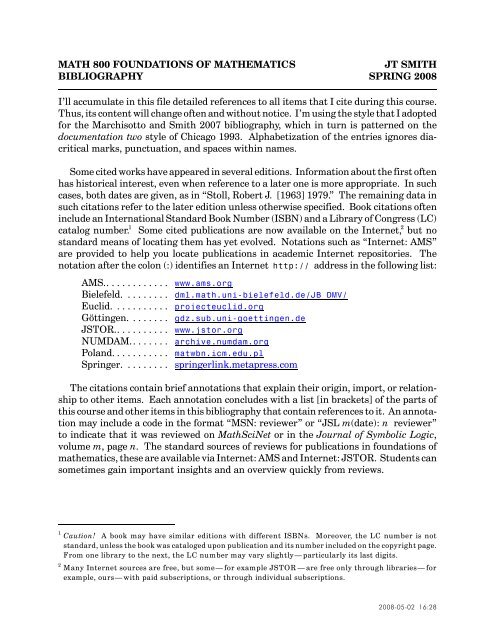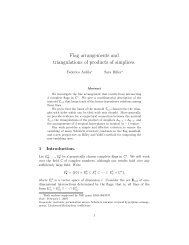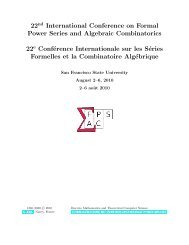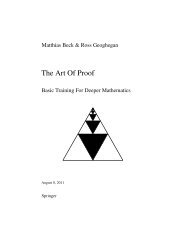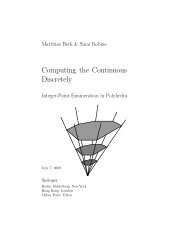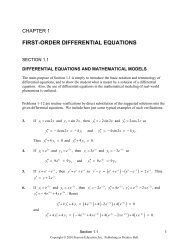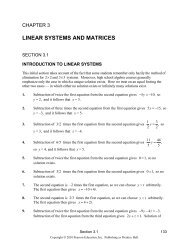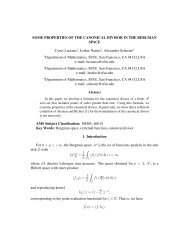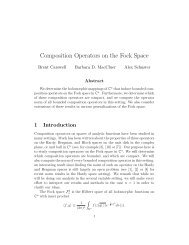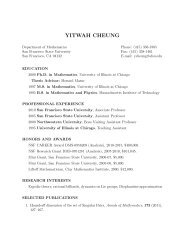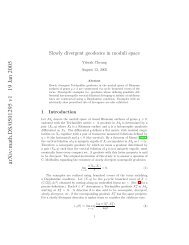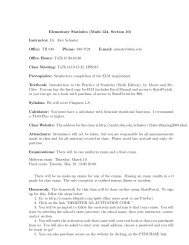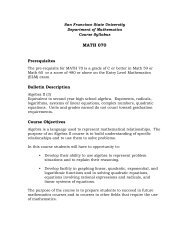Bibliography - Mathematics
Bibliography - Mathematics
Bibliography - Mathematics
You also want an ePaper? Increase the reach of your titles
YUMPU automatically turns print PDFs into web optimized ePapers that Google loves.
MATH 800 FOUNDATIONS OF MATHEMATICS JT SMITH<br />
BIBLIOGRAPHY SPRING 2008<br />
I’ll accumulate in this file detailed references to all items that I cite during this course.<br />
Thus, its content will change often and without notice. I’m using the style that I adopted<br />
for the Marchisotto and Smith 2007 bibliography, which in turn is patterned on the<br />
documentation two style of Chicago 1993. Alphabetization of the entries ignores diacritical<br />
marks, punctuation, and spaces within names.<br />
Some cited works have appeared in several editions. Information about the first often<br />
has historical interest, even when reference to a later one is more appropriate. In such<br />
cases, both dates are given, as in “Stoll, Robert J. [1963] 1979.” The remaining data in<br />
such citations refer to the later edition unless otherwise specified. Book citations often<br />
include an International Standard Book Number (ISBN) and a Library of Congress (LC)<br />
1 2<br />
catalog number. Some cited publications are now available on the Internet, but no<br />
standard means of locating them has yet evolved. Notations such as “Internet: AMS”<br />
are provided to help you locate publications in academic Internet repositories. The<br />
notation after the colon (:) identifies an Internet http:// address in the following list:<br />
1<br />
Caution! A book may have similar editions with different ISBNs. Moreover, the LC number is not<br />
standard, unless the book was cataloged upon publication and its number included on the copyright page.<br />
From one library to the next, the LC number may vary slightly— particularly its last digits.<br />
2<br />
AMS............. www.ams.org<br />
Bielefeld. . . . . . . . . dml.math.uni-bielefeld.de/JB_DMV/<br />
Euclid. . . . . . . . . . . projecteuclid.org<br />
Göttingen. . . . . . . . gdz.sub.uni-goettingen.de<br />
JSTOR.. . . . . . . . . . www.jstor.org<br />
NUMDAM.. . . . . . . archive.numdam.org<br />
Poland. . . . . . . . . . . matwbn.icm.edu.pl<br />
Springer. . . . . . . . . springerlink.metapress.com<br />
The citations contain brief annotations that explain their origin, import, or relationship<br />
to other items. Each annotation concludes with a list [in brackets] of the parts of<br />
this course and other items in this bibliography that contain references to it. An annotation<br />
may include a code in the format “MSN: reviewer” or “JSL m(date): n reviewer”<br />
to indicate that it was reviewed on MathSciNet or in the Journal of Symbolic Logic,<br />
volume m, page n. The standard sources of reviews for publications in foundations of<br />
mathematics, these are available via Internet: AMS and Internet: JSTOR. Students can<br />
sometimes gain important insights and an overview quickly from reviews.<br />
Many Internet sources are free, but some— for example JSTOR — are free only through libraries— for<br />
example, ours— with paid subscriptions, or through individual subscriptions.<br />
2008-05-02 16:28
Page 2 MATH 800 BIBLIOGRAPHY SPRING 2008<br />
Baire, René, Emile Borel, Jacques Hadamard, and Henri Lebesgue. [1905] 1982. Five letters<br />
on set theory. Translated by Gregory H. Moore. In Moore [1982], Appendix I, 311–320.<br />
Originally published as “Cinq lettres sur la théorie des ensembles,” Bulletin de la Société<br />
Mathématique de France 33: 261–273. LC: QA1.S63. Internet: NUMDAM. [Cited in the Maximal<br />
Principles unit.]<br />
Banach, Stefan. 1924. Un théorème sur les transformations biunivoques. Fundamenta Mathematicæ<br />
6: 236–239. LC: QA1.F8. Internet: Poland. [Cited in outline 15.]<br />
Bell, John L., and David H. Fremlin. 1972. The maximal ideal theorem for lattices of sets.<br />
Bulletin of the London Mathematical Society 4: 1–2. LC: QA1.L58.B8. MSN: P. E. Howard.<br />
[Cited in the Maximal Principles unit.]<br />
Bernays, Paul. 1926. Axiomatische Untersuchungen des Aussagenkalküls der Principia Mathematica.<br />
Mathematische Zeitschrift 25. LC: QA1.M3. Internet: Göttingen. This work was<br />
completed in 1919. [Cited in outline 35.]<br />
———. 1941. A system of axiomatic set theory, Part II. Journal of Symbolic Logic 6: 1–17. LC:<br />
BC1.J6. Internet: JSTOR. MSN: H. B. Curry. JSL 3(1938): 49 W. V. O. Quine, 9(1944): 74–75<br />
L. W. Loomis. [Cited in the Axiom of Choice unit.]<br />
Bettazzi, Rodolfo. 1892. Sui punti di discontinuità delle funzioni di variabile reale. Rendiconti<br />
del Circolo Matematico di Palermo 6: 173–195. LC: QA1.C52. [Cited in outline 17.]<br />
———. 1896. Gruppi finiti ed infiniti di enti. Atti della Reale Accademia delle Scienze di Torino<br />
31(1895–1896): 506–512. LC: AS222.A29. Continuation of 1896a. [Cited in outlines 17 and<br />
23.]<br />
Birkhoff, Garrett. 1937. An extended arithmetic. Duke Mathematical Journal 3: 311–316. LC:<br />
QA1.D8. JSL 7(1942): 125–126 A. Church. [Cited in the Partially Ordered Sets unit.]<br />
———. 1948. Lattice Theory. Colloquium publications, volume 25. Revised edition. Providence:<br />
American Mathematical Society. LC: QA171.5.B5. MSN: O. Frink. The first edition was<br />
published in 1940. See also the third edition, 1967. The editions differ considerably. JSL<br />
5(1940): 155–157 H. E. Vaughn, 15(1950): A. Church. [Cited in the Equivalences and Partitions,<br />
Partially Ordered Sets and Complete Lattices units and in outline 5.]<br />
Borel, Émile. 1898. Leçons sur la théorie des fonctions. Paris: Gauthier–Villars. LC: QA331.B6.<br />
[Cited in outline 12.]<br />
Bourbaki, Nicolas. 1939. Éléments de mathématique. Part I: Les structures fondamentales de<br />
l’analyse. Livre I: Théorie des ensembles (Fascicule de résultats). Actualités scientifiques et<br />
industrielles, 846. Paris: Hermann & Cie. LC: QA37.B646. MSN: S. Eilenberg. [Cited in the<br />
Maximal Principles unit.]<br />
———. 1968. Theory of Sets. Elements of mathematics, part 1, book 1. Reading, Massachusetts:<br />
Addison–Wesley. LC: QA248.B73413. MSN: Anonymous. JSL 40(1975): 630–631 P.<br />
Smith. [Cited in the Basic Set Theory unit.]<br />
Burali-Forti, Cesare. [1897] 1970. A question on transfinite numbers. Translated by Jean van<br />
Heijenoort. In Heijenoort [1967] 1970, 104–111. Originally published as “Una questione sui<br />
numeri transfiniti,” Rendiconti del Circolo Matematico di Palermo 11: 154–164, LC: QA1.C52.<br />
[Cited in the Maximal Principles unit.]<br />
Cantor, Georg. 1874 [1996]. On a property of the set of real algebraic numbers. Translated by<br />
William Ewald. In Ewald 1996, volume 2, section 19.A, 839–843. Originally published as<br />
“Über eine Eigenschaft des Inbegriffes aller reellen algebraischen Zahlen,” Journal für die<br />
reine und angewandte Mathematik 77: 258–262, LC: QA1.J6, Internet: Göttingen. [Cited in<br />
the Cardinals II unit.]<br />
2008-05-02 16:28
MATH 800 BIBLIOGRAPHY SPRING 2008 Page 3<br />
———. 1878. Ein Beitrag zur Mannigfaltigkeitslehre. Journal für die reine und angewandte<br />
Mathematik 84: 242–258. LC: QA1.J6. Internet: Göttingen. Reprinted in Cantor [1932] 1962,<br />
119–133. [Cited in outlines 11, 12 and item Cantor [1932] 1962.]<br />
———. 1879–1884. Über unendliche lineare Punktmannigfaltigkeiten. Mathematische Annalen<br />
15(1879): 1–7; 17(1880): 355–358; 20(1882): 113–121; 21(1883): 51–58, 545– 586; 23(1884):<br />
453–488. LC: QA1.M29. Internet: Göttingen. Reprinted in G. Cantor [1932] 1962, 139–<br />
246. Cantor [1883] 1996 is a translation of its fifth part. [Cited in outline 17 and items<br />
G. Cantor [1932] 1962, [1883] 1996.]<br />
———. [1883] 1996. Foundations of a general theory of manifolds: A mathematico-philosophical<br />
investigation into the theory of the infinite. Translated by William Ewald. In Ewald 1996,<br />
volume 2, section 19.C, 878–920. The original book, published by B. G. Teubner, is a reprint,<br />
with additional preface and footnotes, of the fifth part of G. Cantor 1879–1884. [Cited in item<br />
Cantor 1879–1884.]<br />
———. 1884. De la puissance des ensembles parfaits de points. Acta Mathematica 4: 381–392.<br />
LC: QA1.A3. Internet: Springer. Reprinted in Cantor [1932] 1962, 252–260. [Cited in outline<br />
12 and item Cantor [1932] 1962.]<br />
———. 1887–1888. Mitteilungen zur Lehre vom Transfiniten. Zeitschrift für Philosophie und<br />
philosophische Kritik 91: 81–125, 92: 240–265. LC: B3.Z44. Reprinted in Cantor [1932] 1962,<br />
378–439. [Cited in outline 15 and item Cantor [1932] 1962.]<br />
———. [1891] 1996. On an elementary question in the theory of manifolds. Translated by<br />
William Ewald. In Ewald 1996, volume 2, section 19.D, 920–922. Originally published as<br />
“Über eine elementare Frage der Mannigfaltigkeitslehre,” Jahresbericht der Deutschen<br />
Mathematiker-Vereinigung 1: 75–78, LC: QA1.D4, Internet: Göttingen, and reprinted in<br />
Cantor [1932] 1962, 278–281. [Cited in outline 15 and items Cantor [1932] 1962 and Ewald<br />
1996.]<br />
———. [1895–1897] 1952. Contributions to the Founding of the Theory of Transfinite Numbers.<br />
Translated and with a preface, introduction, and notes by Philip E. B. Jourdain, New York:<br />
Dover Publications. LC: QA248.C2. Originally published as “Beiträge zur Begründung der<br />
transfinite Mengenlehre,” Mathematische Annalen 46: 481–512, 49: 207–246, LC: QA1.M29,<br />
Internet: Göttingen, and reprinted in G. Cantor [1932] 1962, 282–356. The translation was<br />
originally published in 1915 by the Open Court Publishing Company. [Cited in outline 15 and<br />
item Cantor [1932] 1962.]<br />
———. [1932] 1962. Gesammelte Abhandlungen mathematischen und philosophischen Inhalts,<br />
mit erläuternden Anmerkungen sowie mit Ergänzungen aus dem Briefwechsel Cantor–<br />
Dedekind. Edited by Ernst Zermelo. With a biography of Cantor by Adolf Fraenkel. Hildesheim:<br />
Georg Olms Verlagsbuchhandlung. LC: QA3.C27. [Cited in items Cantor 1878,<br />
1879–1884, 1884, 1887–1888, [1895–1897] 1952.]<br />
Chicago Manual of Style, The. 1993. Fourteenth edition. Chicago: University of Chicago Press.<br />
LC: Z53.U69. ISBN: 0-226-10389-7. [Cited in this bibliography’s introduction.]<br />
Church, Alonzo. 1956. Introduction to Mathematical Logic. Princeton: Princeton University<br />
Press. LC: BC135.C47. MSN: Gál. Although the title page says volume one, there has never<br />
been a volume two. [Cited in outline 33.]<br />
Cohen, Leon W., and Gertrude Ehrlich. 1963. The Structure of the Real Number System.<br />
Princeton: D. Van Nostrand. LC: QA241.C67. JSL 34(1969): K. Segerberg. [Cited in the Basic<br />
Set Theory unit.]<br />
2008-05-02 16:28
Page 4 MATH 800 BIBLIOGRAPHY SPRING 2008<br />
Cohen, Paul J. 1963. The independence of the continuum hypothesis. Proceedings of the<br />
National Academy of Sciences of the United States of America 50: 1143–1148, 51: 105–110.<br />
LC: Q11.N26. Internet: JSTOR. MSN: A. Mostowski. [Cited in outline 17.]<br />
Conway, John Horton. 1973. Effective implications between the “finite” choice axioms. In<br />
Mathias and Rogers 1973, 439–458. MSN: R. C. Lyndon. [Cited in outline 17.]<br />
Cooke, W. P. 1969. “Rye whiskey” in contrapositive. American Mathematical Monthly 76: 1051.<br />
LC: QA1.A51. Internet: JSTOR. [Cited in outline 29.]<br />
Daub en, Joseph. 1979. Georg Cantor: His <strong>Mathematics</strong> and Philosophy of the Infinite. Princeton:<br />
Princeton University Press. LC: QA248.D27. ISBN: 0-691-08583-8. MSN: H. C. Kennedy.<br />
[Cited in outline 10.]<br />
Davis, Martin. 1958. Computability and Unsolvability. New York: McGraw–Hill Book Company.<br />
LC: QA248.5.D3. MSN: E. Burger. [Cited in outline 12.]<br />
Dedekind, Richard. [1888] 1963. The nature and meaning of numbers. In Dedekind [1901] 1963,<br />
29–115. Reprinted, extensively revised, in Ewald 1996, volume 2, 787–833. Originally<br />
published as Was sind und was sollen die Zahlen, Braunschweig: F. Vieweg, 1888, reprinted<br />
in Dedekind 1930–1932b, volume 3, 335–391. [Cited in the Natural Numbers unit, outlines<br />
9, 17, and items Dedekind [1901] 1963, 1930–1932b, and Ewald 1996.]<br />
———. [1901] 1963. Essays on the Theory of Numbers. Translated by W. W. Beman. New York:<br />
Dover Publications. LC: QA248.D3. Originally published by Open Court (La Salle, Illinois)<br />
in 1901. Reprinted, extensively revised, in Ewald 1996, 765–779,787–833. [Cited in items<br />
Dedekind [1888] 1963 and Ewald 1996.]<br />
———. 1930–1932a. Ähnliche (deutliche) Abbildung und ähnliche Systeme: 1887.7.11. in Dedekind<br />
1930–1932b, volume 3, 447–449. Unpublished manuscript. [Cited in outlines 12, 17.]<br />
———. 1930–1932b. Gesammelte mathematische Werke. Three volumes. Edited by Robert<br />
Fricke, Emmy Noether, and Øystein Ore. Braunschweig: Friedrich Vieweg & Sohn. LC:<br />
QA36.D4. Internet: Göttingen. [Cited in items Dedekind [1888] 1963 and 1930–1932a.]<br />
Enderton, Herbert. 1972. A mathematical introduction to logic. New York: Academic Press.<br />
[Cited in outline ??.]<br />
Enriques, Federigo. 1907. Prinzipien der Geometrie. In Meyer and Mohrmann 1907–1934, part<br />
1, half 1, 1–129. Article III A, B 1. [Cited in outline 12 and item Meyer and Mohrmann<br />
1907–1934.]<br />
Ewald, William B., editor. 1996. From Kant to Hilbert: A Source Book in the Foundations of<br />
<strong>Mathematics</strong>. Two volumes. Oxford: Clarendon Press. LC: QA8.6.F77. ISBN: 0-198-50537-X.<br />
[Cited in item Cantor [1891] 1996.]<br />
Feferman, Anita B., and Solomon Feferman. 2004. Alfred Tarski: Life and Logic. Cambridge,<br />
England: Cambridge University Press. LC: QA29.T32.F44. ISBN: 0-521-80240-7. MSN: J.<br />
W. Dauben. Reviewed in Sinaceur 2007, Wells 2007. Several other reviews are accessible via<br />
Internet: JSTOR. [Cited in outline 9 and items Sinaceur 2007 and Wells 2007.]<br />
Ferreirós Domínguez, José. 1999. Labyrinth of Thought: A History of Set Theory and Its Role<br />
in Modern <strong>Mathematics</strong>. Basel: Birkhäuser Verlag. LC: QA248.F467. ISBN: 3-764-35749-5.<br />
MSN: E. Mendelson. [Cited in outline 10.]<br />
Finberg, David, Matteo Mainetti, and Gian-Carlo Rota. 1996. The logic of commuting equivalence<br />
relations. In Ursini and Aglianò 1996, 69–96. MSN: Y. Rav. [Cited in outline 3 and in<br />
item Ursini and Aglianò 1996.]<br />
Flanders, Harley. 1987. Generating posets. College <strong>Mathematics</strong> Journal 18: 323–327. LC:<br />
QA11.A1.T9. Internet: JSTOR. [Cited in outline 5.]<br />
2008-05-02 16:28
MATH 800 BIBLIOGRAPHY SPRING 2008 Page 5<br />
Fraenkel, Abraham A. 1961. Abstract Set Theory. Second, revised edition. Amsterdam: North-<br />
Holland Publishing Company. LC: QA248.F74. MSN: F. Bagemihl. JSL 28(1963): 168–169<br />
A. Church. [Cited in the Cardinals II unit.]<br />
Franzén, Torkel. 2005. Gödel’s Theorem: An Incomplete Guide to Its Use and Abuse. Wellesley,<br />
Massachusetts: A K Peters. LC: QA9.65.F73. ISBN: 1-56881-238-8. MSN: W. Sieg. [Cited<br />
in the Gödel’s and Tarski’s Theorems unit.]<br />
Frege, Gottlob. [1895] 1980. A critical elucidation of some points in E. Schroeder’s Vorlesungen<br />
ueber die Algebra der Logik. In Frege 1980, 86–106. Originally published as “Kritische<br />
Beleuchtung einiger Punkte in E. Schröders Vorlesung über die Algebra der Logik,” Archiv<br />
für systematische Philosophie und Soziologie (new series) 1: 433–456, LC: B3.A7. [Cited in<br />
outline 17 and item Frege 1980.]<br />
———. [1902] 1970. Letter to Russell. Translated by Beverly Woodward. In Heijenoort [1967]<br />
1970, 126–128. Response to Russell [1902] 1970. [Cited in item Russell [1902] 1970.]<br />
———. 1980. Translations from the Philosophical Writings of Gottlog Frege. Third edition.<br />
Edited by Peter Geach and Max Black, with index by E. D. Klemke. Oxford: Basil Blackwell.<br />
LC: QA8.4.F73. ISBN: 0-631-12911-1. JSL 18(1953): 92–93 A. Church; JSL 46(1981): 870<br />
–871 C. Parsons. [Cited in item Frege [1895] 1980.]<br />
Frewer, M. 1981. Felix Bernstein. Jahresbericht der Deutschen Mathematiker-Vereinigung 83:<br />
84–95. LC: QA1.D4. Internet: Bielefeld. [Cited in outline 12.]<br />
Galvin, Fred. 1994. A proof of Dilworth’s chain decomposition theorem. American Mathematical<br />
Monthly 101: 352–353. LC: QA1.A51. Internet: JSTOR. MSN: Anonymous. [Cited in outline<br />
5.]<br />
George, Alexander. 1987. The imprecision of impredicativity. Mind 96: 514–518. LC: B1.M5.<br />
Internet: JSTOR. [Cited in the Natural Numbers unit.]<br />
Gillman, Leonard. 2002–2003. Two classical surprises concerning the axiom of choice and the<br />
continuum hypothesis. American Mathematical Monthly 109: 544–553, 110: 79–80. LC:<br />
QA1.A51. Internet: JSTOR. [Cited in outline 23.]<br />
Gödel, Kurt. [1931] 1967. On formally undecidable propositions of Principia Mathematica and<br />
related systems I. Translated by Jean van Heijenoort. In Heijenoort [1967] 1970, 592 – 617.<br />
Originally published as “Über formal unentscheidbare Sätze der Principia Mathematica und<br />
verwandter Systeme I,” Monatshefte für Mathematik 38: 173–198. There is no part II. [Cited<br />
the Gödel’s and Tarski’s Theorems unit and item Heijenoort [1967] 1970.]<br />
———. 1938. The consistency of the axiom of choice and of the generalized continuum-hypothesis.<br />
Proceedings of the National Academy of Sciences of the United States of America 24:<br />
556–557. LC: Q11.N26. Internet: JSTOR. JSL 5(1940): 116–117 P. Bernays. [Cited in outline<br />
17.]<br />
———. 1947. What is Cantor’s continuum problem? American Mathematical Monthly 14:<br />
515–525. LC: QA1.A51. Internet: JSTOR. MSN: B. Jónsson. JSL 13(1948): 116–117 S.<br />
Kleene. [Cited in the Cardinals II unit and outline 23.]<br />
Grattan-Guinness, Ivor. 2000. The Search for Mathematical Roots 1870–1940: Logics, Set<br />
Theories and the Foundations of <strong>Mathematics</strong> from Cantor through Russell to Gödel. Princeton:<br />
Princeton University Press. LC: QA248.G684. ISBN: 0-691-05857-1. MSN: R. Murawski.<br />
[Cited in outline 10, 12.]<br />
Harris, John H. 1970. On a problem of Th. Skolem. Notre Dame Journal of Formal Logic 11:<br />
372–374. LC: BC1.N6. Internet: Euclid. MSN: N. H. Williams. JSL 36(1971): 680 Jean<br />
Rubin. [Cited in outline 1.]<br />
2008-05-02 16:28
Page 6 MATH 800 BIBLIOGRAPHY SPRING 2008<br />
Hartogs, Fritz. 1915. Über das Problem der Wohlordnung. Mathematische Annalen 76: 438–<br />
443. LC: QA1.M29. Internet: Göttingen. [Cited in the Cardinals II unit.]<br />
Hausdorff, Felix. 1914. Grundzüge der Mengenlehre. Leipzig: Von Veit. LC: QA248.H4. There<br />
have been several later editions and translations. [Cited in outline 20 and the Maximal<br />
Principles unit.]<br />
Heijenoort, Jean van. [1967] 1970. From Frege to Gödel: A Source Book in Mathematical Logic,<br />
1879–1931. Cambridge, Massachusetts: Harvard University Press. LC: QA9.V3. ISBN: 0-674-<br />
32449-8. MSN: J. W. Dawson. JSL 37(1972): 405, A. Church, 39(1974): 355 A. Church. [Cited<br />
in outline 1 and items Burali-Forti [1897] 1970, Frege [1902] 1970, Gödel [1931] 1967, Russell<br />
[1902] 1970, and Zermelo [1904] 1970, [1908] 1970a, [1908] 1970b.]<br />
Heine, Edouard. 1872. Die Elemente der Functionenlehre. Journal für die reine und angewandte<br />
Mathematik 74: 172–188. LC: QA1.J6. Internet: Göttingen. [Cited in outline 17.]<br />
Heise, Werner. 1971. Das Lemma von Zorn: Eine vergleichende Untersuchung geometrischer,<br />
algebraischer und topologischer Hüllensysteme. Mathematisch-physikalische Semesterberichte<br />
(new series) 19: 73–82. LC: QA1.M288. MSN: A. Appert. [Cited in the Maximal Principles<br />
unit.]<br />
Hessenberg, Gerhard. 1906. Grundbegriffe der Mengenlehre: zweite Bericht über das Unendliche<br />
in der Mathematik. Abhandlungen der Fries’schen Schule (new series) 1 (4): 1–220. LC:<br />
B3.A3. [Cited in the Cardinals II unit and outline 12.]<br />
Hilbert, David. [1900] 2000. Mathematical problems. Translated by Mary Winston Newson.<br />
Bulletin of the American Mathematical Society (new series) 37: 407– 436. LC: QA1.A52.<br />
Internet: AMS. Reprinted from Bulletin of the American Mathematical Society, 8 (1902):<br />
437– 479. Originally published as “Mathematische Probleme,” Nachrichten von der Königlichen<br />
Gesellschaft der Wissenschaften zu Göttingen, Mathematisch-physikalische Klasse 1900:<br />
253–297, LC: AS182.G348, Internet: Göttingen. A shorter French version is included in<br />
International Congress of Mathematicians [1900] 1902, 58–114. [Cited in outline 17 and items<br />
Hilbert [1932–1935] and International Congress of Mathematicians [1900] 1902.]<br />
Holmes, M. Randall. [1998] 2007. Elementary Set Theory with a Universal Set. Cahiers du<br />
Centre de Logique, 10. Second edition manuscript. Available on the Internet at http://<br />
math.boisestate.edu/~holmes/holmes/nf.html. Originally published by Bruylant–<br />
Academia. Reviewed in Jones 2007. [Cited in outline 2 and item Jones 2007.]<br />
Hönig, Chaim Samuel. 1954. Proof of the Well-ordering of Cardinal Numbers. Proceedings of<br />
the American Mathematical Society 5: 312. LC: QA1.A526. MSN: G. Kurepa. [Cited in the<br />
Cardinals II unit.]<br />
International Congress of Mathematicians. [1900] 1902. Compte rendu du Deuxième Congrès<br />
International des Mathématiciens tenu à Paris du 6 au 12 Aout 1900. Procès-verbaux et communications.<br />
Edited by Ernest Duporcq. Paris: Gauthier–Villars. LC: QA1.I8. Reviewed in<br />
Scott 1900–1901. [Cited in entries Hilbert [1900] 2000, Scott 1900–1901.]<br />
International Congress of Mathematicians. [1928] 1930. Atti del Congresso Internazionale dei<br />
Matematici, Bologna, 3–10 Settembre 1928. Six volumes. Bologna: Nicola Zanichelli Editore,<br />
1930. LC: QA1.I8. [Cited in item Tarski [1928] 1930.]<br />
Iseki, Kiyoshi. 1950. On a proposition which is equivalent to the axiom of choice. Journal of<br />
the Osaka Institute of Science and Technology, Part I 2: 109. LC: QA1.F86. MSN: T. Viola.<br />
[Cited in the Cardinals II unit.]<br />
2008-05-02 16:28
MATH 800 BIBLIOGRAPHY SPRING 2008 Page 7<br />
Jech, Thomas. 1994. On Gödel’s second incompleteness theorem. Proceedings of the American<br />
Mathematical Society 121: 311–313. LC: QA1.A526. MSN: Surma. [Cited in the Gödel’s and<br />
Tarski’s Theorems unit.]<br />
Jones, Robert. 2007. Review of Holmes [1998] 2007. Mathematical Intelligencer 29: 71–73. LC:<br />
QA1.M23. [Cited in item Holmes [1998] 2007.]<br />
Jourdain, Philip E. B. 1904a. On the transfinite cardinal numbers of well-ordered aggregates.<br />
London, Edinburgh, and Dublin Philosophical Magazine and Journal of Science (sixth series)<br />
7: 61–75. LC: QC1.P3. [Cited in outline 12.]<br />
———. 1904b. On the transfinite cardinal numbers of number-classes in general. London,<br />
Edinburgh, and Dublin Philosophical Magazine and Journal of Science (sixth series) 7:<br />
294–303. LC: QC1.P3. [Cited in outline 12.]<br />
Kanamori, Akihiro. 1997. The mathematical import of Zermelo’s well-ordering theorem.<br />
Bulletin of Symbolic Logic 3: 281–311. LC: QA9.A1.B89. Internet: JSTOR. MSN: Y. Rav.<br />
[Cited in outlines 15 and 21.]<br />
Kennedy, Hubert C. 1973. What Russell learned from Peano. Notre Dame Journal of Formal<br />
Logic 14: 367–372. LC: BC1.N6. Internet: Euclid. MSN: K. Inoue. [Cited in outline 17.]<br />
Knaster, Bronis³aw, and Alfred Tarski. 1927. Un théorème sur les fonctions d’ensembles.<br />
Annales de la Société Polonaise des Mathématiques 6: 133–134. LC: QA1.P59. [Cited in<br />
outline 15.]<br />
Kneser, Hellmuth. 1950. Eine direkte Ableitung des Zornschen Lemmas aus dem Auswahlaxiom.<br />
Mathematische Zeitschrift 53: 110–113. LC: QA1.M3. Internet: Göttingen. MSN: A. D.<br />
Wallace. [Cited in the Maximal Principles unit.]<br />
Kosmák, Ladislav. 1980. On equivalence relations. Acta Mathematica Universitatis Comenianæ<br />
39: 19–23. LC: QA3.B75.A3. Internet: Göttingen. MSN: D. Kurepa. [Cited in outline 3.]<br />
Kraus, G. A. 1968. Motivation for defining the conditional. American Mathematical Monthly<br />
75: 1103–1104. LC: QA1.A51. Internet: JSTOR. [Cited in outline 6.]<br />
Kuratowski, Casimir. 1921. Sur la notion de l’ordre dans la Théorie des Ensembles. Fundamenta<br />
Mathematicæ 2: 161–171. LC: QA1.F8. Internet: Poland. [Cited in outline 1 and the<br />
Virtual Classes unit.]<br />
———. 1922. Une méthode d’élimination des nombres transfinis des raisonnements mathématiques.<br />
Fundamenta Mathematicæ 3: 76–108. LC: QA1.F8. Internet: Poland. [Cited in<br />
outline 21 and the Maximal Principles unit.]<br />
Kurepa, Djuro. 1952. Sur la relation d’inclusion et l’axiome de choix de Zermelo. Bulletin de<br />
la Société Mathématique de France 80: 225–232. LC: QA1.S63. Internet: NUMDAM. MSN:<br />
E. W. Beth. [Cited in the Maximal Principles unit.]<br />
Kurosh, Aleksandr Gennadievich. 1963. Lectures on General Algebra. Translated by Kurt<br />
August Hirsch. New York: Chelsea Publishing Company. LC: QA155.K813. [Cited in the<br />
Equivalences and Partitions, Partially Ordered Sets, and Complete Lattices unit.]<br />
Levi, Beppo. 1902. Intorno alla teoria degli aggregati. Reale Istituto Lombardo di Scienze e<br />
Lettere: Rendiconti (series 2) 35: 863–868. LC: AS222.I42. [Cited in outline 17.]<br />
Lightstone, A. H. 1965. Symbolic Logic and the Real Number System. New York: Harper & Row,<br />
Publishers. LC: QA255.L55. [Cited in the Paper Topics list.]<br />
Lipschutz, Seymour. 1964. Schaum’s Outline of Theory and Problems of Set Theory and Related<br />
Topics. New York: McGraw–Hill. LC: QA248.L57. ISBN: 0-070-38159-3. [Cited in the Basic<br />
Set Theory unit.]<br />
2008-05-02 16:28
Page 8 MATH 800 BIBLIOGRAPHY SPRING 2008<br />
Lipton, James. 1991. An Exaltation of Larks: The Ultimate Edition. New York: Viking Penguin.<br />
LC: PE1689.L5. ISBN: 0-670-30044-6. Originally published in 1961. There have been several<br />
editions. [Cited in outline 3.]<br />
Marchisotto, Elena A., and James T. Smith. 2007. The Legacy of Mario Pieri in Geometry and<br />
Arithmetic. Boston: Birkhäuser. LC: QA29.P68.M37. ISBN: 978-0-8176-3210-6. MSN: A.<br />
Lewis. [Cited in this bibliography’s introduction, outline 9, and in item Pieri 1907.]<br />
Mathias, A. R. D., and Hartley Rogers, editors. 1973. Cambridge Summer School in Mathematical<br />
Logic, August 1–21, 1971. Lecture notes in mathematics, 337. Berlin: Springer-Verlag.<br />
LC: QA3.L28. ISBN: 978-3-540-05569-3. [Cited in outline 17 and item Conway 1973.]<br />
Meyer, Franz, and Hans Mohrmann, editors. 1907–1934. Encyklopädie der mathematischen<br />
Wissenschaften mit Einschluss ihrer Anwendungen. Volume 3: Geometrie. Leipzig: B. G.<br />
Teubner. LC: QA37.E6. Internet: Göttingen. Three parts; parts 1,2 have two halves; part<br />
2, half 2, has subdivisions A and B. Other volumes and editions have different editors. [Cited<br />
in item Enriques 1907.]<br />
Monk, J. Donald. 1969. Introduction to Set Theory. New York: McGraw–Hill. LC: QA248.M53.<br />
MSN: W. S. Hatcher. JSL 38(1973): 151 J. R. Shoenfield. [Cited in the Basic Set Theory and<br />
Axiom of Choice unit.]<br />
Moore, Gregory H. 1982. Zermelo’s Axiom of Choice: Its Origins, Development, and Influence.<br />
New York: Springer-Verlag. LC: QA248.M59. ISBN: 0-387-90670-3. MSN: C. Smoryñski.<br />
JSL 49(1984): 659–660 J. E. Rubin. [Cited in outline 17, the Axiom of Choice unit and item<br />
Baire et al. [1905] 1982.]<br />
Parsons, Charles D. 1987. Developing arithmetic in set theory without infinity: some historical<br />
remarks. History and Philosophy of Logic 8: 201–213. LC: BC1.H58. MSN: E. Mendelson.<br />
[Cited in the Natural Numbers unit.]<br />
Peano, Giuseppe. [1889] 1973. The Principles of Arithmetic, Presented by a New Method.<br />
Translated by Hubert C. Kennedy. In Peano 1973, 101–134. Translation of Arithmetices Principia,<br />
Nova Methodo Exposita, Turin: Fratres Bocca. [Cited in the Natural Numbers unit and<br />
item Peano 1973.]<br />
———. 1890. Démonstration de l’intégrabilité des équations différentielles ordinaires. Mathematische<br />
Annalen 37: 182–228. LC: QA1.M29. Internet: Göttingen. [Cited in outline 17.]<br />
———. 1973. Selected works of Giuseppe Peano. Translated and edited, with a biographical<br />
sketch and bibliography, by Hubert C. Kennedy. Toronto: University of Toronto Press. LC:<br />
QA3.43131. ISBN: 0-802-05267-3. [Cited in item [1889] 1973.]<br />
Pieri, Mario. 1898. I principii della geometria di posizione composti in sistema logico deduttivo.<br />
Memorie della Reale Accademia delle Scienze di Torino (series 2) 48: 1– 62. LC: AS222.A3.<br />
An English translation is appearing gradually on my website. [Cited in outline 17.]<br />
———. [1907] 2007. On the axioms of arithmetic. In Marchisotto and Smith 2007, 308–<br />
313. Originally published as “Sopra gli assiomi aritmetici,” Bollettino delle sedute della<br />
Accademia Gioenia di Scienze Naturali in Catania (series 2) 1–2(1907–1908): 26–30, LC:<br />
QH7.A33. [Cited in outline 3 and the Natural Numbers unit.]<br />
Quine, Willard v. O. 1969. Set Theory and Its Logic. Revised edition. Cambridge, Massachusetts:<br />
Harvard University Press. LC: QA248.Q5. MSN: Marek. JSL 37(1972): 768–769 G.<br />
T. Kneebone. [Cited in the Natural Numbers unit.]Constance Reid 1996 L<br />
Reid, Constance. 1996. Julia: a life in mathematics. Washington: Mathematical Association<br />
of America. LC: QA29.R575.R45. ISBN: 0883855208. MSN: Murawski. [Cited in outline 36.]<br />
2008-05-02 16:28
MATH 800 BIBLIOGRAPHY SPRING 2008 Page 9<br />
Rosenholtz, Ira. 2000. One point determines a line: a geometric axiom of choice. Math Horizons<br />
(November): 20–24. LC: QA11.A1.M38. [Cited in outline 15.]<br />
Rubin, Herman, and Jean E. Rubin. 1985. Equivalents of the Axiom of Choice. Studies in logic<br />
and the foundations of mathematics, 116. Amsterdam: North-Holland Publishing Company.<br />
LC: BC135.R77. MSN: C. C. Chang, P. Smith. JSL 52(1987): 867–869 D. Pincus. [Cited in<br />
the Axiom of Choice unit.]<br />
Rubin, Jean E. 1967. Set Theory for the Mathematician. San Francisco: Holden–Day. LC:<br />
QA248.R85. MSN: L. Gillman. [Cited in the Cardinals II unit.]<br />
Russell, Bertrand. [1902] 1970. Letter to Frege. Translated by Beverly Woodward. In Heijenoort<br />
[1967] 1970, 124–125. Russell wrote in German. Frege’s response is Frege [1902] 1970.<br />
[Cited in outlines 1, 17 and item Frege [1902] 1970.]<br />
———. 1903. The Principles of <strong>Mathematics</strong>. Cambridge, England: Cambridge University Press.<br />
LC: QA9.R82. Internet: Michigan. There are several newer editions and reprints. Reviewed<br />
in Wilson 1904–1905. [Cited in outline 9 and item Wilson 1904–1905.]<br />
Sageev, Gershon. 1975. An independence result concerning the axiom of choice. Annals of Mathematical<br />
Logic 8: 1–184. LC: QA1.A65. MSN: A. Blass. [Cited in the Cardinals II unit.]<br />
Schock, Rolf. 1966. A simple version of the generalized continuum hypothesis. Notre Dame Journal<br />
of Formal Logic 7: 287–288. LC: BC1.N6. Internet: Euclid. [Cited in the Cardinals II<br />
unit.]<br />
Schoenflies, Arthur. 1900. Die Entwickelung der Lehre von den Punktmannigfaltigkeiten.<br />
Jahresbericht der Deutschen Mathematiker-Vereinigung 8 (second issue). LC: QA1.D4.<br />
Internet: Göttingen. [Cited in outline 12.]<br />
Schröder, Ernst. [1890–1905] 1966. Vorlesungen über die Algebra der Logik (Exacte Logik).<br />
Three volumes. New York: Chelsea Publishing Company. LC: BC135.S36. Originally published<br />
in Leipzig by B. G. Teubner. [Cited in outline 17 and the Partially Ordered Sets unit.]<br />
Schwenk, Allen J. 2002. Comparing ,{} ,{ { }}, etc. College <strong>Mathematics</strong> Journal 33:<br />
232–233. LC: QA11.A1.T9. Internet: JSTOR. [Cited in outline 2.]<br />
Scott, Charlotte A. 1900–1901. The International Congress of Mathematicians in Paris. Bulletin<br />
of the American Mathematical Society 7: 57–79. LC: QA1.A52. Internet: AMS. [Cited in item<br />
International Congress of Mathematicians [1900] 1902.]<br />
Scott, Dana S. 1954. The theorem on maximal ideals in lattices and the axiom of choice. Bulletin<br />
of the American Mathematical Society 60: 83. LC: QA1.A52. Internet: AMS. [Cited in the<br />
Maximal Principles unit.]<br />
Segerkrantz, Jerry. 1998. Inclusion-exclusion and characteristic functions. <strong>Mathematics</strong><br />
Magazine 71: 216–218. LC: QA1.N35. Internet: JSTOR. [Cited in outline 13.]<br />
Sierpinski, Wac³aw. 1947. L’hypothèse généralisée du continu et l’axiome du choix. Fundamenta<br />
Mathematicae 34: 1–5. LC: QA1.F8. Internet: Poland. [Cited in the Cardinals II unit.]<br />
———. 1958. Cardinal and Ordinal Numbers. Monografie matematyczne, 34. Warsaw:<br />
Panstwowe Wydawnictwo Naukowe. LC: QA248.S44. MSN: L. Gillman. [Cited in outlines<br />
15, 17.]<br />
Sinaceur, Hourya Benis. 2007. Review of Feferman and Feferman 2004. Notices of the American<br />
Mathematical Society 54: 986–989. LC: QA1.A525. Internet: AMS. [Cited in outline 9 and<br />
item Feferman and Feferman 2004.]<br />
Smullyan, Raymond M. 1961. Theory of Formal Systems. Annals of <strong>Mathematics</strong> studies, 47.<br />
Princeton: Princeton University Press. LC: QA1.A665. [Cited in the Gödel’s and Tarski’s<br />
Theorems unit.]<br />
2008-05-02 16:28
Page 10 MATH 800 BIBLIOGRAPHY SPRING 2008<br />
———. 1992. Gödel’s incompleteness theorems. Oxford logic guides, 19. New York: Oxford<br />
University Press, Inc. LC: QA9.65.S69. ISBN 0-19-504672-2. MSN: S. Shapiro. [Cited in the<br />
Gödel’s and Tarski’s Theorems unit.]<br />
Stoll, Robert R. [1963] 1979. Set Theory and Logic. New York: Dover Publications. Originally<br />
published by W. H. Freeman. LC: QA248.S7985. ISBN: 0-486-63829-4. MSN: R. L. Wilder.<br />
JSL 29(1964): 40–41 G. T. Kneebone. [An official text for the course, cited in the syllabus and<br />
many outlines, and in the Basic Set Theory and Maximal Principles units.]<br />
Suppes, Patrick. 1960. Axiomatic Set Theory. Princeton: D. Van Nostrand. LC: QA248.S92.<br />
MSN: L. Rieger. JSL 25(1960): 277–278 A. Borgers. [Cited in the Basic Set Theory unit and<br />
outline 10.]<br />
Szpilrajn, Edward. 1930. Sur l’extension de l’ordre partiel. Fundamenta Mathematicæ 16:<br />
386–389. LC: QA1.F8. Internet: Poland. [Cited in the Maximal Principles unit.]<br />
Tarski, Alfred. 1924a. Sur les ensembles finis. Fundamenta Mathematicæ 6: 45–95. LC:<br />
QA1.F8. Internet: Poland. [Cited in the Cardinals I unit and outline 10, 13.]<br />
———. 1924b. Sur quelques théorèmes qui équivalent à l’axiome du choix. Fundamenta<br />
Mathematicæ 5:147–154. LC: QA1.F8. Internet: Poland. On the paper, the author’s surname<br />
is given as Tajtelbaum-Tarski. [Cited in outline 10.]<br />
———. 1927. Quelques théorèmes généraux sur les images d’ensembles. Annales de la Société<br />
Polonaise des Mathématiques 6: 132–133. LC: QA1.P59. [Cited in outline 9.]<br />
———. [1928] 1930. Über Äquivalenz der Mengen in Bezug auf eine beliebige Klasse von<br />
Abbildungen. In International Congress of Mathematicians [1928] 1930, volume 2, 243–<br />
252. [Cited in outline 15 and item International Congress of Mathematicians [1928] 1930.]<br />
———. [1935] 1983. Some methodological investigations on the definability of concepts. In<br />
Tarski [1956] 1983, 296–319. [Cited in outline 12 and item Tarski [1956] 1983.]<br />
———. [1936] 1983. The concept of truth in formalized languages. In Tarski [1956] 1983,<br />
152–278. Originally published as “Der Wahrheitsbegriff in den formalisierten Sprachen,”<br />
Studia Philosophica 1: 261–405, LC: B22.S75. The work was completed and presented in<br />
Polish in 1931. [Cited in the Gödel’s and Tarski’s Theorems unit and item Tarski [1956]<br />
1983.]<br />
———. [1946] 1995. Introduction to Logic and to the Methodology of the Deductive Sciences.<br />
Second, revised edition. Translated by Olaf Helmer. New York: Dover Publications, Inc.<br />
Originally published by Oxford University Press; the Polish first edition appeared in 1936.<br />
LC: QA9.T28. ISBN: 0-486-28462-X. JSL 6(1941):30–32 A. Church, 12(1947): 61 A. Church.<br />
[An official text for the course, cited in the syllabus and many outlines.]<br />
———. 1955. A lattice-theoretical fixpoint theorem and its applications. Pacific Journal of<br />
<strong>Mathematics</strong> 5: 285–309. LC: QA1.P18. Internet: Euclid. MSN: B. Jónsson. JSL 22(1957):<br />
370 H. Gericke. [Cited in the Complete Lattices unit and outlines 12, 15.]<br />
———. [1956] 1983. Logic, Semantics, Metamathematics: Papers from 1923 to 1938. Translated<br />
by J. H. Woodger. Second edition, edited with introduction and analytical index by John<br />
Corcoran. Indianapolis: Hackett Publishing Company. LC: BC135.T35. ISBN: 0-915-14475-1.<br />
MR: E. Mendelson. [Cited in items Tarski [1935] 1983, [1936] 1983.]<br />
———. 1969. Truth and proof. Scientific American 220: 63–77. [Cited in the Gödel’s and<br />
Tarski’s Theorems unit.]<br />
Teichmüller, Oswald. 1939. Braucht der Algebraiker das Auswahlaxiom? Deutsche Mathematik<br />
4: 567–577. LC: QA1.D37. MSN: M. Hall. JSL 6(1941): 65–66 R. Péter. [Cited in Maximal<br />
Principles unit.]<br />
2008-05-02 16:28
MATH 800 BIBLIOGRAPHY SPRING 2008 Page 11<br />
Tuke y, John W. 1940. Convergence and uniformity in topology. Annals of <strong>Mathematics</strong> studies<br />
2. Princeton: Princeton University Press. LC: QA1.A665. MSN: L. W. Cohen. [Cited in the<br />
Maximal Principles unit.]<br />
Ursini, Aldo, and Paolo Aglianò, editors. 1996. Logic and Algebra. Lecture notes in pure and<br />
applied mathematics, 180. New York: Marcel Dekker, Inc., 69–96. LC: QA10.L63. ISBN: 0-<br />
824-79606-1. [Cited in item Finberg et al. 1996.]<br />
Vaught, Robert L. 1952. On the equivalence of the axiom of choice and a maximal principle.<br />
Bulletin of the American Mathematical Society 58: 66. LC: QA1.A52. Internet: AMS. [Cited<br />
in the Maximal Principles unit.]<br />
Veblen, Oswald. 1904. A system of axioms for geometry. Transactions of the American Mathematical<br />
Society 5: 343–384. LC: QA1.A53. Internet: JSTOR. [Cited in outline 12.]<br />
Wagon, Stan. 1985. The Banach–Tarski paradox. Cambridge: Cambridge University Press.<br />
LC: QA248.W22. MSN: W. Bzyl. [Cited in outline 17.]<br />
Wells, Benjamin. 2007. Alfred Tarski, Friend and Daemon. Notices of the American Mathematical<br />
Society 54: 982–984. LC: QA1.A525. Internet: AMS. [Cited in outline 9 and item Feferman<br />
and Feferman 2004.]<br />
Whitehead, Alfred N. 1902. On cardinal numbers. American Journal of <strong>Mathematics</strong> 24:<br />
367–394. LC: QA1.A5. Internet: JSTOR. [Cited in outline 12.]<br />
Whitehead, Alfred N., and Bertrand Russell. 1910–1913. Principia Mathematica. Three volumes.<br />
Cambridge, England: The University Press. LC: QA9.W5. [Cited in the Partially Ordered Sets<br />
unit.]<br />
Wilson, Edwin B. 1904–1905. The foundations of mathematics. Bulletin of the American<br />
Mathematical Society 9: 74–93. LC: QA1.A52. Internet: AMS. Review of Russell [1897] 1956,<br />
1903. [Cited in item Russell 1903.]<br />
Zermelo, Ernst. 1901. Ueber die Addition transfiniter Cardinalzahlen. Nachrichten von der<br />
Gesellschaft der Wissenschaften zu Göttingen, Mathematisch-Physikalische Klasse 1901: 34–<br />
38. LC: AS182.G348. Internet: Göttingen. [Cited in outline 12.]<br />
———. [1904] 1970. Proof that every set can be well-ordered. Translated by Stefan Bauer-<br />
Mengelberg. In Heijenoort [1967] 1970, 139–141. Originally published as “Beweis, dass jede<br />
Menge wohlgeordnet werden kann,” Mathematische Annalen 59: 514–516, LC: QA1.M29,<br />
Internet: Göttingen. [Cited in outlines 17 and 21, the Maximal Principles unit, and item<br />
Heijenoort [1967] 1970.]<br />
———. [1908] 1970a. Investigations in the foundations of set theory, I. Translated by Stefan<br />
Bauer-Mengelberg. In Heijenoort [1967] 1970, 199–215. Originally published as “Untersuchungen<br />
über die Grundlagen der Mengenlehre, I,” Mathematische Annalen 59: 261–281,<br />
LC: QA1.M29, Internet: Göttingen. [Cited in the Axiom of Choice unit.]<br />
———. [1908] 1970b. A new proof of the possibility of a well-ordering. Translated by Stefan<br />
Bauer-Mengelberg. In Heijenoort [1967] 1970, 183–198. Originally published as “Neuer<br />
Beweis für die Wohlordnung,” Mathematische Annalen 65: 107–128, LC: QA1.M29, Internet:<br />
Göttingen. [Cited in the Maximal Principles unit.]<br />
Zorn, Max. 1935. A remark on method in transfinite algebra. Bulletin of the American Mathematical<br />
Society 41: 667–670. LC: QA1.A52. Internet: AMS. [Cited in outline 21 and the Maximal<br />
Principles unit.]<br />
———. 1944. Idempotency of infinite cardinals. University of California Publications in <strong>Mathematics</strong><br />
(new series) 2: 9–12. LC: QA1.C2. MSN: L. Loomis. [Cited in the Cardinals II unit.]<br />
2008-05-02 16:28


